Engaging in breeding geese is beneficial. By 4-5 months one individual can weigh up to 5 kg (live weight). But food can not be the same for all periods of life.
In this article we will look at such pressing questions as: what to feed the goslings? How to feed goslings in the first days of life at home? How to give fish oil to goslings? What are the nuances of successful cultivation? What is better: incubator or natural incubation? Is there any difference what to feed from the first day and in a month? And what should be the food for each age period?
Table of contents
- Proper maintenance and feeding of newborns, weekly and monthly goslings at home
- Temperature and care for offspring grown in an incubator in the first days of life
- Offspring grown by natural means (hen)
- Table of norms of feed for goslings of different ages
- Euphorbia and nettle: what kind of grass can I give?
- Diseases of two weeks geese
Proper maintenance and feeding of newborns, weekly and monthly goslings at home
Incubation of a goose egg lasts a standard 30 days. The temperature during the incubation period is maintained around 38 degrees. But sooner or later, the newborn babies will leave the warm, cozy incubator, and then the question of further content will appear.
The temperature regime is most important for goslings in the first 10 days, Since thermoregulation is not yet developed and the body is not kept warm, it is impossible to keep little goslings on the street. This leads to loss of heat and the risk of loss of brood. To avoid such incidents, the temperature must be maintained artificially and sufficiently high.
Temperature and care for offspring grown in an incubator in the first days of life
The first three days are heated more intensely. The temperature is maintained around 28-30 degrees. The temperature will be comfortable for goslings if:
- kids spend most of their time around the feeder;
- rest on the litter without trying to fold more compactly at the heat source;
- chicks have a normal appetite and thirst.
Then by the 3rd week the temperature is gradually reduced to 20 degrees, or even 18. In terms of temperature, geese are more adapted to the environment. Unlike other poultry, the goslings have a shorter heating period, only 20-30 days.
If the heater is not enough and the temperature is below the required, you can use infrared lamps (fix at an angle).
Warm air is very pleasant, but do not forget that any heater dries the air, and therefore you need to take care of humidity. Humidity index, the first 10 (15) days, should not be less than 70%, then you need to reduce to 60%.
To maintain the required level of humidity, it is necessary to spray the floor of the room in which the animals live, and if necessary to lower the level of humidity, they resort to airing.
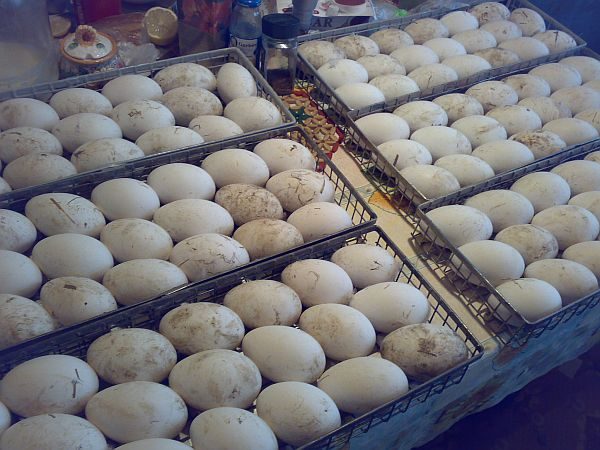
Offspring grown by natural means (hen)
A hen heats and protects eggs throughout the entire period of hatching. If the incubator turns the eggs on average once every two hours, the hen makes it up to 50 times a day, which is 4 times more often. The result of her efforts is immediately visible - the output of young stock is higher. The temperature and humidity under the goose is optimal for eggs.
Nature laid so that the hen provides uniform heating, periodic ventilation and does not overdry eggs. But, as elsewhere there is one drawback - under the goose you can put no more than 15 eggs, otherwise the quality of incubation decreases.
Having entrusted incubation to the hen, all that remains is to take care of the bird itself.It is necessary to provide free access to food, water and the opportunity to swim. There were cases when especially impressionable hens were afraid to get off the nest and walk to the feeder, which could lead to the death of the hen if it were not for forced feeding.
The importance of daylight for chicks up to a month
Regardless of how the chicks were bred, it should be noted that the length of daylight directly affects development, the intensity of weight gain and the health of the goslings.
The first days (about 7 days) should provide round-the-clock coverage of the chicks' dwelling, This will allow you to quickly get used to and easily find food and water. It’s still worth dividing day and night, even without turning off the light, but only muffling, but there should be a difference.
After a week, daylight hours can be reduced to 16-17 hours. But not sharply, but gradually, daily to reduce the time of intense illumination by about 30-40 minutes. Bringing the period of the day to 16-17 hours, you can adhere to such a schedule until sending for slaughter.
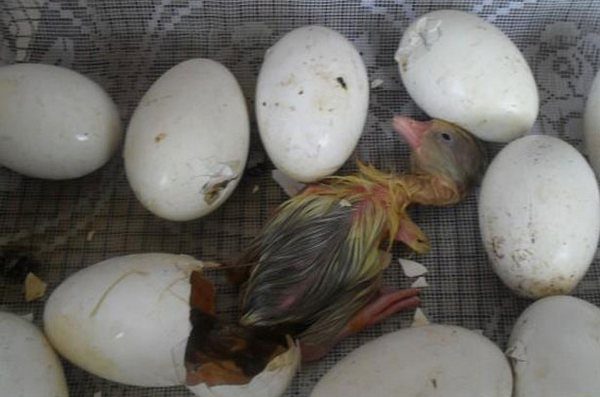
When should chicks fledge?
Goslings have a plumage gradually. From the moment of hatching to full plumage takes about 75-80 days.
The first 20 days the babies walk covered with a fluff, the next 10 days can be observed as steering feathers appear (on the tail), after another 10 days the wings are fledged, these feathers are called terry feathers, then gradually and more or less evenly by 2-3 months full plumage occurs .
How to feed and water daily goslings
So, the goslings hatched, feeders and water at the ready, the room is warm and light, but how to fill the feeders? The period of feeding in goslings begins immediately after they have dried.
First feeding should consist of food already familiar to their body - this is egg yolk. The yolk should be cooked hard-boiled, slightly diluted with boiled water and carefully crushed. This is the diet for the first 3-4 days. Then you can offer young green onions. It should be thoroughly chopped and mixed with the yolk. If the pieces are larger than 2-3 millimeters, the goslings may not swallow the food.
Weekly and two weekly lures. The first 10 days of babies are fed at least 7 times a day, making a break for the night. After some time (a week and a half), you can begin to enter high-calorie feed, about 15% of the total diet.
Food should be rich in fiber, it can be:
- mixer from:
crushed grain;
bran;
grated carrots;
finely chopped eggs;
clover greens;
nettle;
alfalfa;
legumes;
grass grasses; - boiled cereals (wheat, corn, millet);
- boiled potatoes (not more than 10% of the daily value).
Complementary food at the age of 1 month. Closer to the month old, you can begin to practice walking and feeding in the fields (pens). For this it is important to choose a place where the grass is not trampled and not eaten. Geese will find themselves suitable leaves or roots. In this case, you can completely abandon the additional dry food. It is important to consider that greens should form the basis of the diet.
Under the condition of a normal reaction to food, you can begin to feed goslings with beets, carrots and pumpkin already from 4 weeks of age, fresh vegetables are rich in vitamins and microelements, which will only benefit.
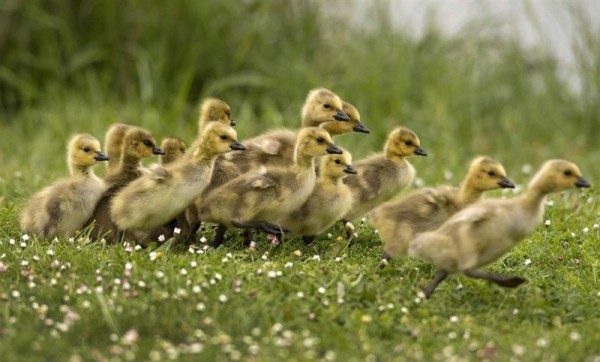
The period from 4 to 8 weeks will determine the profitability of the whole idea with the breeding of geese.Starting from the 4th week of life, the goose body is already accustomed to different calorie and not very good food, which means it is ready to absorb and grow. The basis of weight gain is the core of the grain (a storehouse of calories and flour). If you do not skimp on this albeit expensive, but very effective food, then the kids will gain 2-3 kg per month precisely and as a result - a high weight gain for a shorter period of maintenance.
It does not hurt to pay attention to the especially beloved food, try to give the food that they love and add various high-calorie supplements there (bone meal, wheat flour, vitamins). You can give sunflower cake, mixed with their usual food in the ratio of about 25 grams of cake per 100 grams of feed (1 time in 3 days, otherwise there is a risk of indigestion)
Table of norms of feed for goslings of different ages
Food largely determines the proper cultivation of geese. It is important to take into account the need of the body and ensure the supply of sufficient amounts of vitamins and other nutrients and food. To do this, there are recommendations regarding the daily diet and feeding schedule: the daily volume of fresh greens should not be less than 2 kg per goose.
Approximate consumption rate of greens and grain per individual (daily calculation)
| Approximate consumption rate of greens and grain per individual (daily calculation) | ||
| Age in days | Grain / feed (gr) | Greens (gr) |
| 1-10
11-20 21-30 31-40 41-50 51-60 61-70 71-75 |
20
55 120 140 160 180 200 220 |
50
100 200 300 400 500 600 700 |
| Total for 75 days | 9, 85 kg. | 25 kg. |
The daily feeding schedule during the cold season looks like this:
- 6-7 hours - ⅓ norms of grain and dry flour mixture;
- 14-15 hours - fodder mixture with the addition of vegetables: sugar beet (chopped), wrinkled boiled potatoes, etc .;
- 19-20 hours - ⅔ norms of grain with a dry flour mixture.
| Feed / age in days | 5-10 | 11-20 | 21-30 | 31-40 | 41-60 |
| Cereal feed | 21 | 41 | 97 | 97 | 100 |
| Wheat bran | 6 | 13 | 40 | 50 | 60 |
| Dry animal feed | 4 | 10 | 15 | 15 | 12 |
| Red carrot | 20 | 20 | 20 | — | — |
| Bean greens | 20 | 60 | 100 | 200 | 400 |
| Milk shot | 50 | 50 | 2 | — | — |
| Ground shell | 0,5 | 1 | 3 | 4 | 5 |
In addition to beets and potatoes, you can dilute the diet with such products as:
- vitamin hay or dust;
- flour (fish, meat and bone);
- carrot;
- mineral feed;
- beans;
- pickled peas;
- flaxseed, sunflower, soybean meal;
- blood;
- boiled and chopped fish;
- cottage cheese;
- milk.
River sand and gravel should become an essential ingredient, they should be poured directly into the feeders. Plus, be sure to water the kids.
The daily feeding schedule in the warmer months is much simpler, the basic ration is greens, which they themselves find, you can additionally feed them with fresh chopped vegetables (vegetable waste), 50-70 grams per head per day will be more than enough.
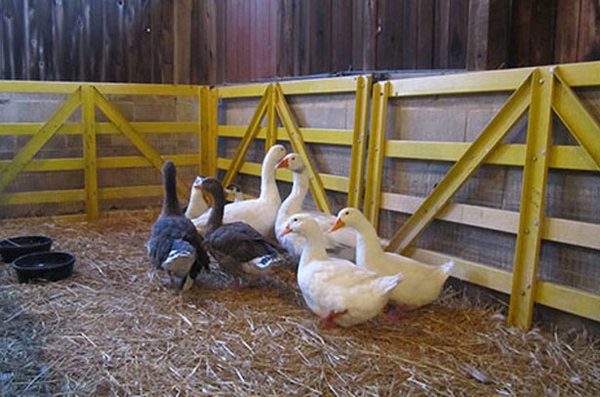
Euphorbia and nettle: what kind of grass can I give?
Adult geese by smell can identify dangerous grass and bypass it, but young individuals can sometimes be mistaken. and eat a leaf of another dangerous weed, what will make your digestive problems and poisoning. To prevent such problems, you should fence access of the young to the forbidden plants, as well as should be protected from eating green potatoes and potato tops.
You can give:
- young nettles, especially freshly harvested (but you can replace with ascorbicum, a teaspoon per liter of water);
- knotweed;
- beet leaves;
- carrot tops;
- spurge;
- alfalfa;
- dandelion;
- sorrel;
- yarrow;
- osenity;
- horsetail;
- wheat grass;
- meadow grass;
- young oats and rye;
- swamp duckweed.
Dangerous plants for geese:
- lily of the valley;
- quinoa;
- ragweed.
Should I give fish oil and how?
Fish oil to give goslings can and should be.It is especially necessary during the period when it is not possible to give the bird juicy food. Fish oil replenishes vitamin deficiencies.
Trivit and tetravin preparations are provided for poultry feeding, feeding recommendations are indicated in the instructions for use. It will be necessary to know exactly the age of the goslings for the calculation of the norm. It turns out about 1.5-2%.
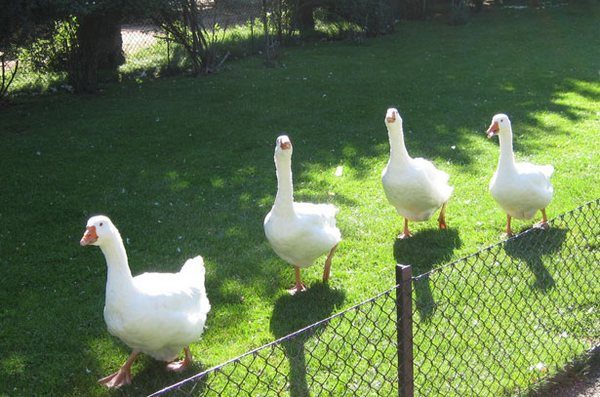
Diseases of two weeks geese
Diseases related to geese can be divided into several categories.
- Non-contagious diseases These include beriberi, rickets, diarrhea and the like. For the treatment of such diseases, it is necessary to look for the cause in the mode of the day and the diet and content. They can manifest themselves in one or several individuals, but the epidemics should not be expected, since they are not contagious.
- Genital diseases, it is yolk peritonitis, it is treated with careful care of the reproductive system and careful care.
- Infectious diseases, such as: aspergillosis, salmonellosis, cholera and others. Such diseases are either difficult to treat or not curable and one must be prepared to kill all the infected birds and thoroughly disinfect the room in which the geese lived.
- Diseases caused by parasites. Whether it is skin parasites or living inside the body, it is necessary and it is necessary to get rid of them and it is desirable to carry out more preventive actions.
- Diseases provoked by toxic substances (poisoning). To prevent poisoning, you need to ensure that there is no mold in the feed, there are no forbidden plants in the pasture and to monitor chemicals that can also cause poisoning.
Healthy goslings are the joy of a farmer and the prospect of a good income. In the care they are not particularly whimsical, but to observe how a yellow lump hatch from the eggs, which then grows into a healthy, strong goose, a real reward for any breeder.
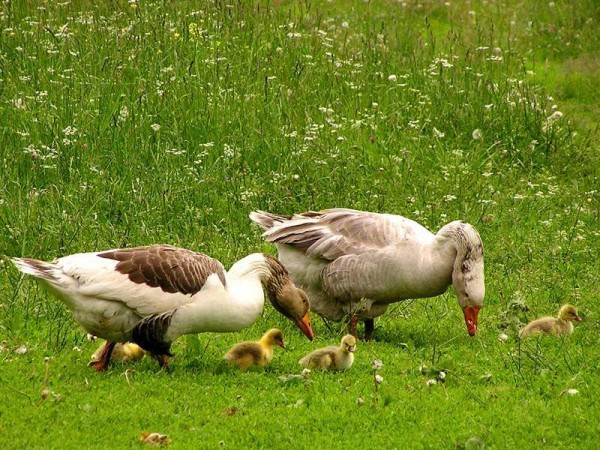
My grandmother always kept geese. I always grazed them (in the spring they always hatched), as soon as they were on their feet, on green grass. But for me, the discovery that they can and should be given fish oil. But we never gave, probably because we grazed on natural.